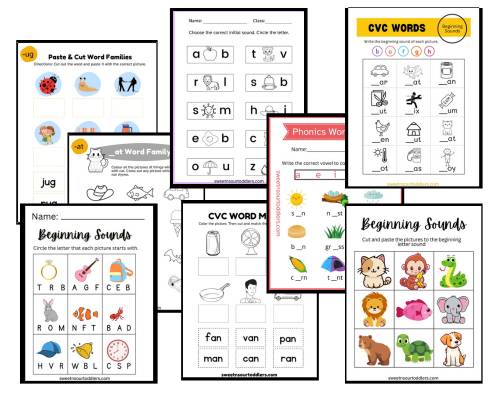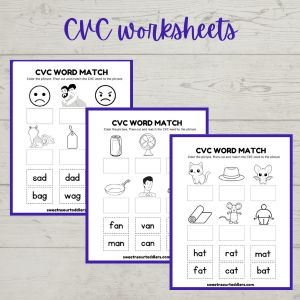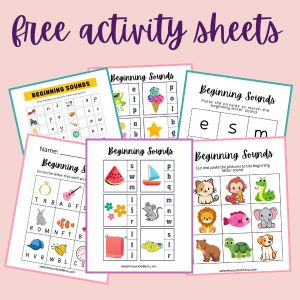Super fun phonics activities your child will love playing.
My child was reading by the age of 2.5. I get so many questions from astounded parents on how I made that happen!
Honestly, when my child was 2.5, teaching her to read was the LAST thing on my mind. I was much too preoccupied with other more pressing parenting challenges like potty training and taming tantrums.
If you’re interested, you can read my more detailed post where I talk about how I taught my 2.5 year old to read.
Playing reading games and doing fun reading activities played a huge role in my journey of getting my child to love reading.
Today I’d like to share with you some of my favorite reading games and activities that you can start playing with your child.
I’ve also created some super fun reading worksheets that are simple enough for a 2-3 year old to do and covers the fundamentals of reading. You can grab your free download at the end of this post.
This post is about phonics activities for preschoolers
This post contains affiliate links. As an Amazon Associate I earn from qualifying purchases.
Phonics Activities That Help Make Reading Fun
Children learn through play, so try incorporating phonics activities at home that involve playing. Make sure that whatever activity you choose you are intentional with your language, as this will help to develop their language skills.
readingeggs
1. DIY Playdough Letters
A good way to introduce phonics to your child is by teaching them how to create letters out of playdough.
This hands-on activity will not only help your child learn letter sounds but also enhance their motor skills.

All you need is some playdough and a playdough mat or table where they can work.
If your child keeps forgetting what the letter looks like, you can even place a flashcard in front of them of the letter they are trying to create.
This activity will keep your child engaged while promoting memory retention and letter recognition skills.
Bonus: make it more fun by using lots of different playdough colors!
12-Pack of Non-Toxic Play-Doh Bulk Winter Colors
2. Phonics Scavenger Hunt
To take your child’s phonics learning to the next level, try out a Phonics Scavenger Hunt!
This activity is a creative way to encourage your child to identify phonetic sounds and improve their problem-solving skills.
Create a list of sounds and hide objects around the house that begin with those sounds. For instance, if the sound is “buh,” hide a ball or a book.
Let your child find each item on the list and say the corresponding sound out loud.
This activity is an excellent opportunity to help your child have fun while learning.
Bonus: it promotes critical thinking and imagination skills.
3. Phonics Bingo
Phonics Bingo is not only a great way to reinforce your child’s phonics learning but also promotes their listening and concentration skills.
To play Phonics Bingo, create a grid of nine squares and write a phonetic sound in each square.
Then, hand your child a set of small objects such as beans, buttons, or chips (make sure they are not a choking hazard!)
Call out a sound and have your child place an object on the corresponding square. Once they have covered three squares in a row, they can shout “Bingo!” and the game is won.

Phonics Bingo is a fantastic way to keep your child engaged in learning and make phonics fun.
If you’re short on time and don’t want to make the game from scratch, you can get a ready made Alphabet Bingo game like this one!
4. Letter Puzzles
Letter Puzzles are another great way to help your child improve their phonics skills.

Here are some some super cute letter puzzles on Amazon for helping kids learn phonics in a fun way:
Learning Resources 3-Letter Word Puzzle Cards, Kindergarten Readniness
80 Words Self-Correcting Spelling Puzzles
As they work on the puzzles, encourage your child to say the name of each letter out loud.
This will help them connect the letter sounds to the actual words and improve their phonetic awareness.
Phonics Activities For Developing a Strong Reading Foundation
5. Silly Sentences
Once your child has mastered the letter sounds, it’s important to put their phonetic knowledge into practice.
Silly Sentences is a fun and engaging way to do just that!
Encourage your child to use the sounds they have learned to construct wacky and nonsensical sentences.
This activity not only helps them develop their phonetic awareness but also boosts their creativity and imagination.
To get started, provide your child with a set of phonetic sound cards and a set of word cards. Ask them to choose one sound card and one word card at random and combine them to form a sentence.
For example, “The silly snake sings on the swing.” The more ridiculous the sentence, the better!
As your child becomes more confident, you can make the game even more challenging by asking them to come up with longer sentences or to use specific sounds.
Looking for fun phonics games? These are some of the bestselling phonics games that children, parents and teachers alike are loving:
Phonics Made Easy, Word Families, Picture Words, High-Frequency Words, Beginning Reading
Learning Resources Snap It Up! Phonics & Reading Card Game
Coogam Wooden Short Vowel Reading Letters Sorting Spelling Games
LITTLE BUD KIDS Spin-and-Read Montessori Phonetic Reading Blocks
6. Phonics Hopscotch
Phonics Hopscotch is an interactive activity that can help your child practice phonics while having fun.
To get started, draw a hopscotch board on the ground using chalk or tape.
Label each square with a letter or a sound, and instruct your child to jump on each square while saying the letter or sound out loud.
For example, if the square is labeled with the letter “B”, your child should say “B” out loud as they jump on it.
As your child becomes more confident, you can make the game even more challenging by asking them to come up with longer sentences or to use specific sounds.
7. Phonics Memory Match
Phonics Memory Match is another engaging game you can play with your child to help them develop their phonics skills.
To play this game, you will need to create a set of cards with different phonics sounds on them. You can use index cards or simply cut out paper into small squares.
To start, lay the cards on a table or the floor face down. Your child can then take turns flipping two cards over to see if they match.
If they do, they get to keep the cards and have another turn. If they don’t match, they have to flip them back over and try again on their next turn.
Trying to teach your child reading at home and don’t know where to begin?
When my daughter was two and a half, teaching her to read was the last thing on my mind. Like most toddler parents, I was much too preoccupied with challenges like potty training and managing tantrums.
I stumbled upon Children Learning Reading totally by accident. I watched in jaw drop amazement videos of kids as kids as young as 2 sounding out words and reading full sentences.
I was so honestly so skeptical about trying it out.
My first thought was that my child was way too young to start. My second thought was that it would take too much effort and time and I didn’t have either to spare.
I put aside these limiting thoughts and instead thought: what do I have to lose?
And so I started.
I spent 10 minutes a day and much to my amazement, within a few weeks of using Children Learning Reading my child was reading 3 letter words! She soon progressed to reading sentences and then little short stories.

I can not begin to describe the joy you feel when you see your little one confidently finish reading a story by themselves from beginning to end!She’s 5 now, reads at 3rd grade level and I literally need to ask her to come out of her reading corner!
If you’re interested, you can read my detailed post on how I taught my child to read: what are the things that worked for us, what I learned from the whole process of teaching my child to read and what I’d recommend you to do.
Check out Children Learning Reading and see why 70,000 plus parents have used this reading program (with zero teaching experience) to see some incredible results!
8. Rhyme Time Activities
Rhyming is a fundamental aspect of the English language and a crucial skill for young readers to develop.
Rhyme Time encourages children to identify and create words that share similar ending sounds. You can start by saying a word and asking your child to come up with a word that rhymes with it.
For example, you could say “cat,” and your child could respond with “mat” or “bat.”
To make the game more engaging, you could create a list of words that your child can use as a reference.
Rhyme Time is an excellent way to practice phonemic awareness and develop vocabulary skills.
As your child becomes more confident in identifying rhyming words, they may even begin to create their own rhymes, further improving their reading skills.
9. Alphabetical Order Race
Another fun activity to try out is the Alphabetical Order Race. This game encourages your child to identify and order letters of the alphabet while also practicing their phonetic knowledge.
To set up the game, create a list of words for your child to put in alphabetical order.
You can also use flashcards with words and pictures to help them associate the word with the sound.
To make it even more engaging, you can time your child and see if they can beat their previous time in putting the words in order.
Encourage your child to stand up and act out each word as they say it, further reinforcing their understanding of phonics.
10. Phonics Karaoke
Incorporating movement into phonics activities can make them more engaging for children.
It adds an element of excitement and can help reinforce their understanding of phonics.
One fun activity to try with your child is Phonics Karaoke.
Phonics Karaoke involves singing along to popular nursery rhymes with phonics-focused lyrics. It’s a great way for children to practice their phonics skills while having fun.
As they sing along to the lyrics, they’ll be reinforcing their understanding of phonics and sounding out words.
Looking for phonics worksheets that help your child practice their reading skills in a fun and engaging way? I’ve put together some amazing activity sheets that will get your kids hooked onto reading!

These reading activity sheets cover the fundamentals of reading like beginning sounds, CVC words and word families etc and are simple enough for a 2-3 year old to do easily.
They also incorporate super fun elements like matching, cutting and pasting, coloring and tracing.
Sign up below and I’ll send these straight to your inbox!
Best resources on Amazon for Phonics flashcards, Picture Words and Sight Words:
Phonics Made Easy, Word Families, Picture Words, High-Frequency Words, Beginning Reading
GAMENOTE Sight Words Kids Educational Flash Cards with Pictures & Sentences
Think Tank Scholar 652 Sight Words/Phonics Flash Cards, Learn to Read
This post was about phonics activities for preschoolers
Don’t forget to check out Children Learning Reading to see why parents are drooling over this crazy simple yet effective Reading Program for kids.
We think you’ll enjoy reading these posts next:
7 Creative Ways to Teach a Toddler to Love Reading
5 Toddler Pre-Reading Skills and How to Inculcate Them
10 Inspiring Ideas For Setting Up An Insanely Cute Toddler Reading Corner
Children Learning Reading Review – An Honest Opinion From a Mom





Leave a Reply